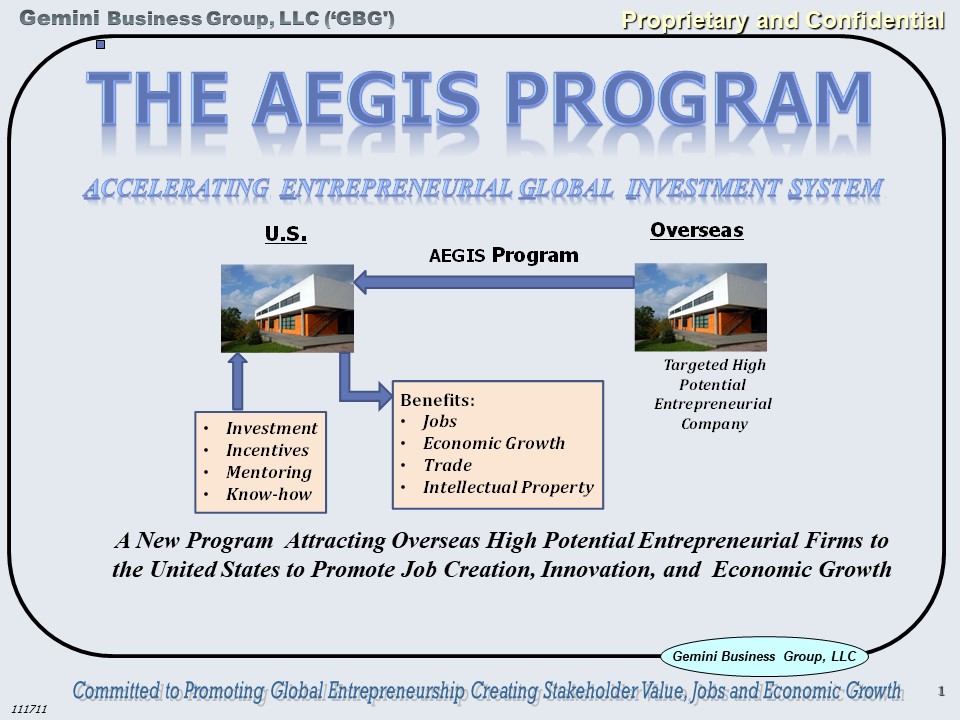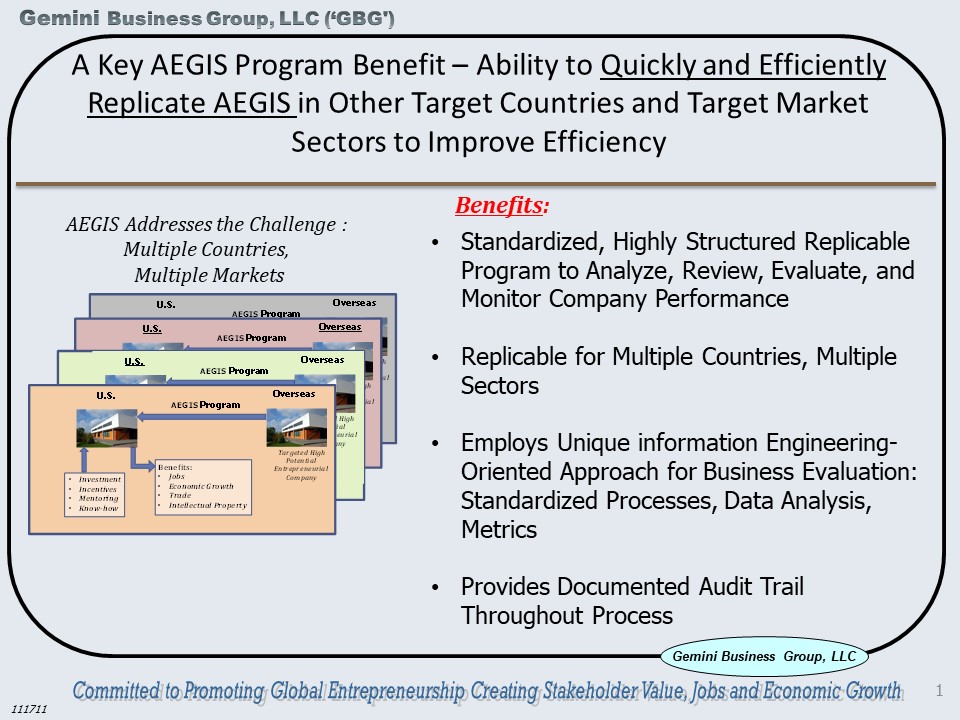A New Initiative Promoting Global Entrepreneurship...
The Triple E Programs are a new three-tiered initiative launched by the Gemini Business Group to promote global entrepreneurship.
You will be hearing more about the Triple E initiative in coming months as we formalize the Program’s Advisory Board with members in the U.S. and abroad.
Entrepreneurship is a driving force in today’s economy. A review of key statistics shows the impact of today’s entrepreneurial revolution and the contribution of entrepreneurial firms (less than 500 employees):
- Today there are 27.8 million entrepreneurial businesses in the United States with fewer than 500 employees, accounting for 99.7 percent of all businesses. And 90 percent have fewer than 20 employees
- Emerging firms (less than 500 employees) accounted for 64 percent of all new jobs created in the past 15 years
- Fifty-five million people work in entrepreneurial firms, representing 49 percent of all employees and 42 percent of all salaries
- Entrepreneurial firms hire 43 percent of all high tech employees
- Entrepreneurial firms represent 97 percent of all exporting firms.
While the contribution of entrepreneurial firms to today’s economic growth is impressive, the rate of technology changes, market disruptions and global business developments will drive even

greater entrepreneurial opportunities and challenges in the coming decade.
The new Triple E - Entrepreneurial Education and Empowerment Programs are launched to address this need with a multi-pronged entrepreneurship initiative. You will hear more about upcoming plans in early 2020. See highlights below.
Entrepreneurship Education for Young Adults
Many resources exist to help entrepreneurs launch new ventures. Through teaching, publication of two entrepreneurial management books and mentoring early stage entrepreneurial managers, the firm’s Managing Partner is also addressing this need.
But young adult entrepreneurs have been largely overlooked. While some educational programs exist, and more are developing, we can do much more to promote interest and entrepreneurial education for young adults.
“Across the U.S., a growing movement is teaching kids to become entrepreneurs--or at least how to think like entrepreneurs…” – that was emphasized in a February 2017 Inc.com article (These
Nine Organizations Are Turning Kids Into Entrepreneurs https://www.inc.com/tom-foster/how-kids-become-entrepreneurs.html). Non-profit groups such as Junior Achievement, the Horatio Alger Society and others are also committed to helping educate young entrepreneurs.
But progress has been slow. In a blog post, “Teaching High School Students Entrepreneurship Drives Jobs And Economic Growth,” the firm’s Managing Partner shared comments he posted on a Washington Post article “Trade Geometry Class for Entrepreneurship”
The blog post emphasized “…high school is a great place to start, but we also need engineers and scientists. These programs really create what I define as ‘entrepreneurial thinking’ which empowers students to be creative, to “think out of the room” as I define it, and help create our next generation of entrepreneurs and in-company entrepreneurs (or “Intrapreneurs”).” You can read the article and posted comments at Teaching High School Students Entrepreneurship
That article and blog post are dated October 25, 2011, about eight years ago. Progress has indeed been slow.
And many young adults are attracted to the scale of the opportunity to create new industries or disrupt existing ones. Consider Dell, Microsoft, Home Depot, Apple, Amazon.com and Starbucks. All created new market sectors or dramatically reshaped existing ones. All launched as entrepreneurial ventures in the past thirty-five years, some even started in a garage.
Consider the Google revolution. Founded in 1998 by two Stanford university students, started erie a basic search engine, ramped up sales to $137 billion in 2018, and achieved a market cap of about $859 billion in October 2019. Compare that to General Motors, started in 1908, lead sales for 77 consecutive years from 1931 to 2007, reported revenue of $147 billion in 2018, and is valued at less than $51 billion today, or about six percent of Google. Dramatic examples showing markets and sectors reshaping, some companies emerging, others disappearing, and creating wealth for founders. Today's technology drivers are driving exponential value creation opportunities.
Helping two teenagers plan, launch and manage their new venture, turn their idea into an opportunity, is the journey young adult readers will take with the two teenagers in ‘Freddie and Billie’s New Business Adventure’. Helping young adults understand how to plan, launch and manage new entrepreneurial ventures is the Managing Partner's mission for ‘Freddie and Billie’s New Business Adventure’. Paul Silverman’s third entrepreneurship book uses a structured, easy to understand, ‘Business in a BoxTM’ planning system developed to introduce young readers to the new venture development process. ‘Freddie and Billie’s New Business Adventure’ is the initial book in the Doc Larsen Business Adventure Series for young adults, planned for launch starting early 2020. Strategic alliance discussions have started with regional and national education organizations that share the Managing Partner's vision for developing new entrepreneurial education programs targeting young adult entrepreneurs. For more more information on upcoming publications, click here.

Smart City Projects Drive Entrepreneurial Opportunities and Economic Growth
The firm’s Managing Partner has experience in the global smart city sector.
New technology developments in 5G, Internet of Things (IoT), big data, edge computing, AI, sensor technologies and analytics are accelerating smart city development and jumpstarting exciting new smart city embryonic entrepreneurial opportunities.
A September 2018 Entrepreneur.com article (“Why Smart Cities Are a Golden Opportunity for Entrepreneurs”) notes “…the list of what city leaders value, and how they differ from city to city, is likely endless. The challenges are often so unique that solutions to address them don't exist -- and requires someone who knows the city intimately to build it. But, this means that entrepreneurs worldwide who are invested in and proud of their home cities, have an advantage over "non-locals."
For example, Barcelona, a leading smart city player, employs a ‘smart hub’, using a mix of high and low technology to benefit its citizens. According to IoT World Today, the city monitors air pollution by tracking air quality sensors through the city, enabling civic leaders to benchmark progress on regulation and air quality initiatives. We can cite many examples worldwide of similar initiatives. Many of these follow the Singapore IoT hub model to jump-start local entrepreneurial- fueled innovation. Others are exploring creative industry/government initiatives to achieve the same objectives. Fueled by rapid technology innovation, smart cities are a multidisciplinary solutions. The Triple E program has targeted the smart city arena and you can expect to see announcements in coming weeks, including a planned upcoming national conference focusing on smart city entrepreneurial opportunities.
Global Entrepreneurship Programs Drive Economic Growth
Today’s approach to evaluate and attract high potential overseas companies to the U.S. is costly, inefficient, and time consuming.
The firm’s Managing Partner developed a new program to attract overseas entrepreneurial firms to the United States to promote job creation, innovation, and economic growth. The program, AEGIS (“Accelerated Entrepreneurial Global Investment System), is being enhanced and relaunched in 2020. Targets for the new program are state and regional governments seeking to attract overseas entrepreneurial firms their region; universities seeking to promote tech transfer opportunities; and government agencies promoting increased US trade.
The AEGIS Program Streamlines Today’s Unstructured Approach to Attract Overseas High Potential Entrepreneurial Firms to the U.S.

Today’s process is challenging:
- Ad-hoc process – no standards exist for evaluation, analysis selection process or key metrics
- Time consuming and costly to start a program in a new country or in new market – no economy of scale
- Selection of potential investment partners ad-hoc, not optimized to attract broadest partner base
- No formal ongoing process to track company key performance indicators and provide management support/mentoring
The AEGIS Program provides benefits:
- Standardized processes, data analysis, metrics
- Provides documented audit trail throughout process
- Highly structured
- Employs proven information engineering and modeling concepts to optimize the process
- Uses defined evaluation and performance metrics to ensure consistent, measurable results
- Ensures all process activities and data are auditable
A key AEGIS Program benefit – the ability to quickly and efficiently replicate AEGIS in other target countries and target market sectors to improve efficiency.
AEGIS Addresses the Challenge: Multiple Countries,
Multiple Markets
The AEGIS Program can accelerate growth of entrepreneurial business opportunities leveraging international business
opportunities. Summary of AEGIS Program benefits:
- Jumpstarts an expanded highly visible effort
to attract high potential overseas entrepreneurial firms to enter the U.S. market - Replaces today’s ad-hoc approach to identify,
analyze, track and manage new ventures with a highly structured, well-defined program - Builds a base of ‘showcase; companies in targeted sectors (e.g., alternative energy, bio-tech, health care, others) that
provide high upside, economic benefits, and positive public support - New U.S. entities have global reach creating possible export opportunities
